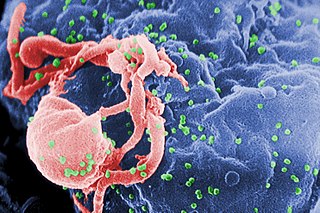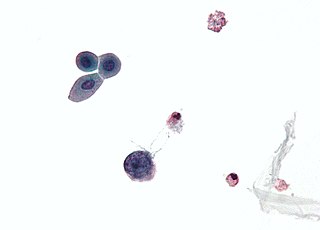
Syphilis is a sexually transmitted infection caused by the bacterium Treponema pallidum subspecies pallidum. The signs and symptoms of syphilis vary depending in which of the four stages it presents. The primary stage classically presents with a single chancre but there may be multiple sores. In secondary syphilis, a diffuse rash occurs, which frequently involves the palms of the hands and soles of the feet. There may also be sores in the mouth or vagina. In latent syphilis, which can last for years, there are few or no symptoms. In tertiary syphilis, there are gummas, neurological problems, or heart symptoms. Syphilis has been known as "the great imitator" as it may cause symptoms similar to many other diseases.

The Mantoux test or Mendel–Mantoux test is a tool for screening for tuberculosis (TB) and for tuberculosis diagnosis. It is one of the major tuberculin skin tests used around the world, largely replacing multiple-puncture tests such as the tine test. The Heaf test, a form of tine test, was used until 2005 in the UK, when it was replaced by the Mantoux test. The Mantoux test is endorsed by the American Thoracic Society and Centers for Disease Control and Prevention. It was also used in the USSR and is now prevalent in most of the post-Soviet states.
Hairy leukoplakia, is a white patch on the side of the tongue with a corrugated or hairy appearance. It is caused by Epstein-Barr virus (EBV) and occurs usually in persons who are immunocompromised, especially those with human immunodeficiency virus infection/acquired immunodeficiency syndrome (HIV/AIDS). This white lesion cannot be scraped off. The lesion itself is benign and does not require any treatment, although its appearance may have diagnostic and prognostic implications for the underlying condition.

Mycosis is a fungal infection of animals, including humans. Mycoses are common and a variety of environmental and physiological conditions can contribute to the development of fungal diseases. Inhalation of fungal spores or localized colonization of the skin may initiate persistent infections; therefore, mycoses often start in the lungs or on the skin.
Ichthyosis acquisita is a disorder clinically and histologically similar to ichthyosis vulgaris.
The CDC Classification System for HIV Infection is the medical classification system used by the United States Centers for Disease Control and Prevention (CDC) to classify HIV disease and infection. The system is used to allow the government to handle epidemic statistics and define who receives US government assistance.
ICD-10 is an international statistical classification used in health care and related industries.
Latent tuberculosis (LTB), also called latent tuberculosis infection (LTBI) is when a person is infected with Mycobacterium tuberculosis, but does not have active tuberculosis. Active tuberculosis can be contagious while latent tuberculosis is not, and it is therefore not possible to get TB from someone with latent tuberculosis. The main risk is that approximately 10% of these people will go on to develop active tuberculosis. This is particularly true, and there is added risk, in particular situations such as medication that suppresses the immune system or advancing age.

Human immunodeficiency virus infection and acquired immune deficiency syndrome (HIV/AIDS) is a spectrum of conditions caused by infection with the human immunodeficiency virus (HIV). Following initial infection, a person may not notice any symptoms or may experience a brief period of influenza-like illness. Typically, this is followed by a prolonged period with no symptoms. As the infection progresses, it interferes more with the immune system, increasing the risk of developing common infections such as tuberculosis, as well as other opportunistic infections, and tumors that rarely affect people who have uncompromised immune systems. These late symptoms of infection are referred to as acquired immunodeficiency syndrome (AIDS). This stage is often also associated with unintended weight loss.
Eosinophilic folliculitis is an itchy rash with an unknown cause that is most common among individuals with HIV, though it can occur in HIV-negative individuals where it is known by the eponym Ofuji disease. EF consists of itchy red bumps (papules) centered on hair follicles and typically found on the upper body, sparing the abdomen and legs. The name eosinophilic folliculitis refers to the predominant immune cells associated with the disease (eosinophils) and the involvement of the hair follicles.
Venereology is a branch of medicine that is concerned with the study and treatment of sexually transmitted diseases. The name derives from Roman goddess Venus, associated with love, beauty and fertility. A physician specializing in venereology is called a venereologist. In many areas of the world, the specialty is usually combined with dermatology.

Maraviroc is an antiretroviral drug in the CCR5 receptor antagonist class used in the treatment of HIV infection. It is also classed as an entry inhibitor. It also appeared to reduce graft-versus-host disease in patients treated with allogeneic bone marrow transplantation for leukemia, in a phase 1/2 study.
Chronic actinic dermatitis is a condition where a subject's skin becomes inflamed due to a reaction to sunlight or artificial light. Patients often suffer from other related conditions of the skin that cause dermatitis in response to a variety of stimuli.

Sexually transmitted infections (STI), also referred to as sexually transmitted diseases (STD), are infections that are commonly spread by sexual activity, especially vaginal intercourse, anal sex and oral sex. Many times STIs initially do not cause symptoms. This results in a greater risk of passing the disease on to others. Symptoms and signs of disease may include vaginal discharge, penile discharge, ulcers on or around the genitals, and pelvic pain. STIs can be transmitted to an infant before or during childbirth and may result in poor outcomes for the baby. Some STIs may cause problems with the ability to get pregnant.
Steroid acne is an adverse reaction to corticosteroids, and presents as small, firm follicular papules on the forehead, cheeks, and chest. Steroid acne presents with monomorphous pink paupules, as well as comedones, which may be indistinguishable from those of acne vulgaris. Steroid acne is commonly associated with endogenous or exogenous sources of androgen, drug therapy, or diabetes and is less commonly associated with HIV infection or Hodgkin's disease.

Erythema dyschromicum perstans (EDP) is an uncommon skin condition with peak age of onset being young adults, but it may also be seen in children or adults of any age. EDP is characterized by hyperpigmented macules that are ash-grey in color and may vary in size and shape. While agents such as certain medications, radiographic contrast, pesticides, infection with parasites, and HIV have been implicated in the occurrence of this disease, the cause of this skin disease remains unknown.
HIV-associated lipodystrophy, also known as lipodystrophy in HIV-infected patients (LD-HIV), is a condition characterized by loss of subcutaneous fat associated with infection with HIV.
Photosensitivity with HIV infection is a skin condition resembling polymorphous light eruption, actinic prurigo, or chronic actinic dermatitis, seen in about 5% of HIV-infected people.
Granuloma annulare in HIV disease is a skin condition characterized typically by papular and generalized skin lesions.
HIV-associated pruritus is a cutaneous condition, an itchiness of the skin, that occurs in up to 30% of HIV infected people, occurs when the T-cell count drops below 400 per cubic mm.








